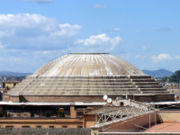
Roman Architectural Revolution
Encyclopedia

Roman architecture
Ancient Roman architecture adopted certain aspects of Ancient Greek architecture, creating a new architectural style. The Romans were indebted to their Etruscan neighbors and forefathers who supplied them with a wealth of knowledge essential for future architectural solutions, such as hydraulics...
of the previously little-used architectural forms of the arch
Arch
An arch is a structure that spans a space and supports a load. Arches appeared as early as the 2nd millennium BC in Mesopotamian brick architecture and their systematic use started with the Ancient Romans who were the first to apply the technique to a wide range of structures.-Technical aspects:The...
, vault
Vault (architecture)
A Vault is an architectural term for an arched form used to provide a space with a ceiling or roof. The parts of a vault exert lateral thrust that require a counter resistance. When vaults are built underground, the ground gives all the resistance required...
and dome
Dome
A dome is a structural element of architecture that resembles the hollow upper half of a sphere. Dome structures made of various materials have a long architectural lineage extending into prehistory....
. For the first time in history, their potential was fully exploited in the construction of a wide range of civil engineering structures, public buildings, and military facilities. These include: Roman amphitheatres, Roman aqueduct
Roman aqueduct
The Romans constructed numerous aqueducts to serve any large city in their empire, as well as many small towns and industrial sites. The city of Rome had the largest concentration of aqueducts, with water being supplied by eleven aqueducts constructed over a period of about 500 years...
s, Roman baths
Thermae
In ancient Rome, thermae and balnea were facilities for bathing...
, Roman bridges, Roman circuses, Roman dams, Roman domes, Roman harbours, and Roman temple
Roman temple
Ancient Roman temples are among the most visible archaeological remains of Roman culture, and are a significant source for Roman architecture. Their construction and maintenance was a major part of ancient Roman religion. The main room housed the cult image of the deity to whom the temple was...
s.
A crucial factor in this development that saw a trend to monumental architecture was the invention of Roman concrete
Roman concrete
Roman concrete was a material used in construction during the late Roman Republic through the whole history of the Roman Empire. Roman concrete was based on a hydraulic-setting cement with many material qualities similar to modern Portland cement...
(also called Opus caementicium), which led to the liberation of the shape from the dictate of the traditional materials of stone and brick.
For the first time in recorded history we find evidence of an interest in the shapes of the space contained strong enough to outweigh the functional logic of the masonry masses that contained it. There was nothing new in the employment of curvilinear or polygonal forms, as such...But in so far as such buildings incorporated curvilinear or polygonal rooms and corridors, the shapes of these were determined by the form of the building as a whole, not by any aesthetic principle.
The development of Roman architecture, however, did not remain limited to these new forms and materials. An unrelated process of architectural innovation continued unabated, which, although less conspicuous, proved their usefulness for solving structural problems and found their way permanently into Western architecture, such as the lintel arch
Lintel (architecture)
A lintel can be a load-bearing building component, a decorative architectural element, or a combined ornamented structural item. It is often found over portals, doors, and windows.-Structural uses:...
, the independent corbel
Corbel
In architecture a corbel is a piece of stone jutting out of a wall to carry any superincumbent weight. A piece of timber projecting in the same way was called a "tassel" or a "bragger". The technique of corbelling, where rows of corbels deeply keyed inside a wall support a projecting wall or...
, and the metal-tie.
See also
- Roman architectureRoman architectureAncient Roman architecture adopted certain aspects of Ancient Greek architecture, creating a new architectural style. The Romans were indebted to their Etruscan neighbors and forefathers who supplied them with a wealth of knowledge essential for future architectural solutions, such as hydraulics...
- Roman engineeringRoman engineeringRomans are famous for their advanced engineering accomplishments, although some of their own inventions were improvements on older ideas, concepts and inventions. Technology for bringing running water into cities was developed in the east, but transformed by the Romans into a technology...
- Roman technologyRoman technologyRoman technology is the engineering practice which supported Roman civilization and made the expansion of Roman commerce and Roman military possible over nearly a thousand years....
- Pozzolanic reactionPozzolanic reactionThe Pozzolanic reaction is the chemical reaction that occurs in hydraulic cement, a mixture of slaked lime with amorphous siliceous materials , forming non-water-soluble calcium silicate hydrates...
External links
- Traianus - Technical investigation of Roman public works
- The Roman Pantheon: The Triumph of Concrete
- Fikret Yegul: Roman Concrete
- Roman aqueducts: Types of Opus Caementicium walls

